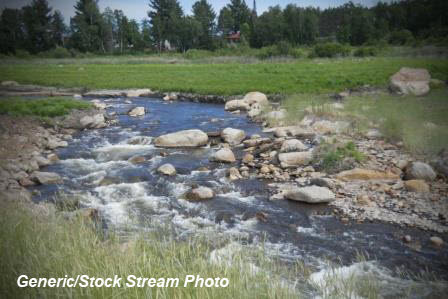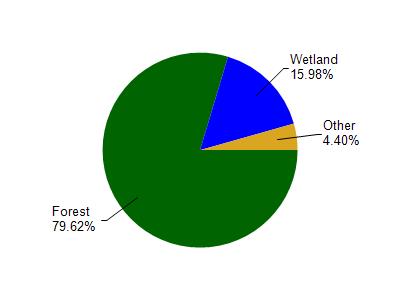
9.55 Miles
8.96 - 18.51
Cool-Cold Headwater, Coldwater, Cool-Warm Headwater
2014
Suspected Poor
Iron
Yes
Yes
No
Fish and Aquatic Life
Overview
This stream is Class III trout water in its lower reaches near the confluence with the Potato River, and a Class II trout fishery in its upper reaches until it becomes largely bounded by wetlands. Wisconsin Trout Streams identifies the boundary between the two classes as occurring at the stream crossing in Section 9 in Ashland County. This road crossing actually occurs in Section 10. In Ashland County, the stream flows through the Bad River Indian Reservation. Unstable bottom conditions and wildly fluctuating water levels limit this portion of the stream as a trout water. The Iron County portions of the river are also subject to stream flow fluctuations, with low flows a common problem. The community of Saxon discharges effluent to Vaughn Creek just a few miles from the headwaters in an area of wetlands. Prior to the construction of the wastewater treatment plant, water quality sampling indicated combined septic tank effluent from Saxon harmed the creek. The stretch of this creek from the outfall in T46N R1W S1 NE to the west boundary of the section is recommended for inclusion in NR 104 as a limited forage fishery. Upstream of this reach, primarily wetland flow, is probably only supporting a limited forage fish community. We have no recent data on this stream. Much of the watershed is forested with a likelihood for varying approaches to forest management that could threaten the stream.
During survey work conducted as part of the coastal wetlands evaluation, no species of macroinvertebrate were found and overall taxa richness was moderate (5-24 species) (Epstein 1997). At the survey site, streambank erosion is a significant pollutant source, with urban inputs a threat; silt is a significant factor affecting habitat quality.
Turville-Heitz, Meg. 1999. Lake Superior Basin Water Quality Management Plan. Wisconsin Department of Natural Resources, Madison, WI.
Date 1999
Author Aquatic Biologist
Condition
Wisconsin has over 84,000 miles of streams, 15,000 lakes and milllions of acres of wetlands. Assessing the condition of this vast amount of water is challenging. The state's water monitoring program uses a media-based, cross-program approach to analyze water condition. An updated monitoring strategy (2015-2020) is now available. Compliance with Clean Water Act fishable, swimmable standards are located in the Executive Summary of Water Condition in 2018. See also the 'monitoring and projects' tab.
Reports
Recommendations
Monitor Aquatic Biology
Conduct biological (mIBI or fIBI) monitoring on Vaughn Creek, WBIC: 2906300, AU:17691
Management Goals
Wisconsin's Water Quality Standards provide qualitative and quantitative goals for waters that are protective of Fishable, Swimmable conditions [Learn more]. Waters that do not meet water quality standards are considered impaired and restoration actions are planned and carried out until the water is once again fishable and swimmable
Management goals can include creation or implementation of a Total Maximum Daily Load analysis, a Nine Key Element Plan, or other restoration work, education and outreach and more. If specific recommendations exist for this water, they will be displayed below online.
Monitoring
Monitoring the condition of a river, stream, or lake includes gathering physical, chemical, biological, and habitat data. Comprehensive studies often gather all these parameters in great detail, while lighter assessment events will involve sampling physical, chemical and biological data such as macroinvertebrates. Aquatic macroinvertebrates and fish communities integrate watershed or catchment condition, providing great insight into overall ecosystem health. Chemical and habitat parameters tell researchers more about human induced problems including contaminated runoff, point source dischargers, or habitat issues that foster or limit the potential of aquatic communities to thrive in a given area. Wisconsin's Water Monitoring Strategy was recenty updated.
Grants and Management Projects
Monitoring Projects
| WBIC | Official Waterbody Name | Station ID | Station Name | Earliest Fieldwork Date | Latest Fieldwork Date | View Station | View Data |
|---|
| 2906300 | Vaughn Creek | 10029522 | VAUGHN CREEK IMMEDIATELY DOWNSTREAM OF WYLAND RD | 11/28/2006 | 11/28/2006 | Map | Data |
| 2906300 | Vaughn Creek | 263008 | Saxon Stp | | | Map | Data |
| 2906300 | Vaughn Creek | 10032648 | Vaughn Creek at Hwy. 122 Saxon | | | Map | Data |
| 2906300 | Vaughn Creek | 10029520 | VAUGHN CREEK at CURRY RD - UPSTREAM | 11/28/2006 | 11/28/2006 | Map | Data |
| 2906300 | Vaughn Creek | 263033 | Vaughn Creek at Hwy 169 Nr Gurney | 6/22/1979 | 10/6/1979 | Map | Data |
| 2906300 | Vaughn Creek | 10033483 | Vaughn Creek at Lower Rd | | | Map | Data |
| 2906300 | Vaughn Creek | 10029521 | VAUGHN CREEK CLEMENT RD - UP and DOWNSTREAM | 11/28/2006 | 11/28/2006 | Map | Data |
| 2906300 | Vaughn Creek | 10043261 | Vaughn Creek at Hwy 169 | 6/1/2013 | 11/1/2014 | Map | Data |
|

Watershed Characteristics
Vaughn Creek is located in the Potato River watershed which is 139.92 mi². Land use in the watershed is primarily forest (79.70%), wetland (16%) and a mix of grassland (2.40%) and other uses (2.00%). This watershed has 306.29 stream miles, 195.98 lake acres and 14,309.56 wetland acres.
Nonpoint Source Characteristics
This watershed is ranked Not Ranked for runoff impacts on streams, Not Available for runoff impacts on lakes and Low for runoff impacts on groundwater and therefore has an overall rank of Low. This value can be used in ranking the watershed or individual waterbodies for grant funding under state and county programs.However, all waters are affected by diffuse pollutant sources regardless of initial water quality. Applications for specific runoff projects under state or county grant programs may be pursued. For more information, go to surface water program grants.
Vaughn Creek is considered a Cool-Cold Headwater, Coldwater, Cool-Warm Headwater under the state's Natural Community Determinations.
Natural communities (stream and lake natural communities) represent model results and DNR staff valiation processes that confirm or update predicted conditions based on flow and temperature modeling from historic and current landscape features and related variables. Predicated flow and temperatures for waters are associated predicated fish assemblages (communities). Biologists evaluate the model results against current survey data to determine if the modeled results are corect and whether biological indicators show water quaity degradation. This analysis is a core component of the state's resource management framework. Wisconsin's Riverine Natural Communities.
Cool (Warm-Transition) Headwaters are small, sometimes intermittent streams with cool to warm summer temperatures. Coldwater fishes are uncommon to absent, transitional fishes are abundant to common, and warm water fishes are common to uncommon. Headwater species are abundant to common, mainstem species are common to absent, and river species are absent.
Cool (Cold-Transition) Headwaters are small, usually perennial streams with cold to cool summer temperatures. Coldwater fishes are common to uncommon (<10 per 100 m), transitional fishes are abundant to common, and warm water fishes are uncommon to absent. Headwater species are abundant to common, mainstem species are common to absent, and river species are absent.